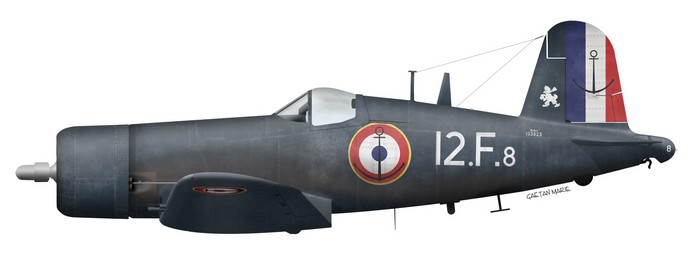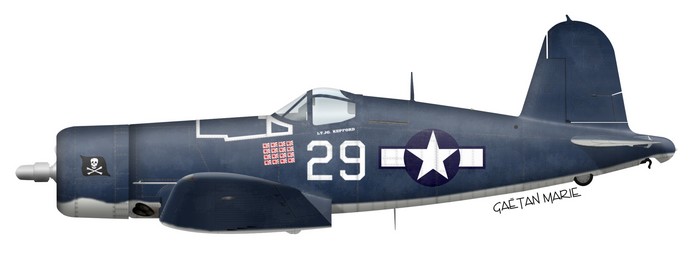The Corsair was the US Navy’s best performer in WW2 but was a difficult aircraft to fly. In comparison the Hellcat was safer, cheaper and easier to build, at the expense of slightly inferior performance. Aces like Gregory Boyington ensured the “bent-wing bird’s” fame rapidly, and the aircraft remained in service with various airforces long after the war.
[Author’s note: The #1 and #2 illustrations on this page were “improved” in 2009, as the original illustrations were quite frankly ugly. Even the improved versions have ample room for yet more improvement. The creation of a high-quality Corsair template has been on the backfire for a while, but I hope to be able to post some good “bent wing bird” profiles on the website soon!]

1. The French Navy was the sole operator of the F4U-7 variant. This aircraft belonged to Flottille 12.F, based on the carrier Bois Belleau operating off the Indochinese coast in 1954.

2. F4U-1A of VF-17, flown by Lt (jg) Ira C. Kepford, Bougainville, 1944. Kepford was credited with a total of 19 Japanese aircraft shot down.

3. Corsair I flown by 1835 Squadron of the Fleet Air Arm, Brunswick, Maine, late 1943. The colours are Ocean Grey and Dark Slate Grey, with Sky underside. The FAA was the first arm to operate the Corsair from carriers, well before the US Navy. The British pilots were trained in Maine and then sent back to the UK.

3. F4U-1D flown by Lt.Cdr. Roger Hedrick, VF-84, USS Bunker Hill, January 1945. The arrow is the carrier’s recognition mark, and was also painted on the uppersurface of the right wing and the undersurface of the left wing.
1 thought on “Vought F4U Corsair”